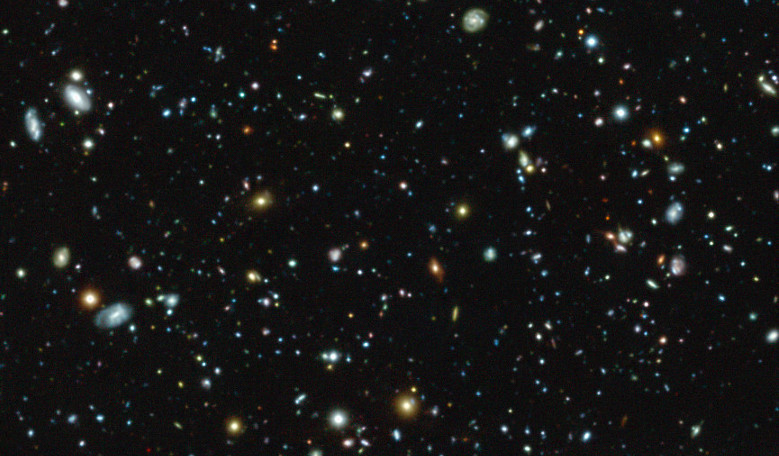Astronomers have spotted 72 new galaxies and measured the distances and properties of 1600 very faint galaxies in the deepest spectroscopic survey conducted yet of the Hubble Ultra Deep Field. This is around ten times as many galaxies that have previously been painstakingly observed over the last decade by ground-based telescopes.
The Hubble Ultra Deep Field (HUDF) – a relatively tiny patch of sky located in the southern constellation of Fornax (The Furnace) – is one of the most extensively studied areas of space.
The original and now iconic HUDF images were at the time (over 13 years ago) pioneering deep-field observations taken with the NASA/ESA Hubble Space Telescope. And since then, 13 instruments on eight telescopes have observed the field covering nearly the complete electromagnetic spectrum from X-ray to radio wavelengths.
Despite the years of research already conducted into the HUDF, with the help of MUSE (Multi Unit Spectroscopic Explorer) on ESO’s Very Large Telescope in Chile, astronomers have produced a groundbreaking dataset that has already resulted in 10 science papers which are being published in a special issue of the Astronomy & Astrophysics journal.
“MUSE can do something that Hubble can’t — it splits up the light from every point in the image into its component colours to create a spectrum. This allows us to measure the distance, colours and other properties of all the galaxies we can see — including some that are invisible to Hubble itself,” said Roland Bacon of the Centre de recherche astrophysique de Lyon, France who led the the MUSE HUDF Survey team.
Those 72 galaxies which have previously gone unnoticed by Hubble have been identified as Lyman-alpha emitters. These type of galaxies only shine in Lyman-alpha light which is produced when electrons in hydrogen atoms drop from the second-lowest to the lowest energy level. When this happens a precise amount of energy is released as light with a particular wavelength in the ultraviolet part of the spectrum. These type of galaxies are something of a conundrum as our current understanding of star formation cannot fully explain why they seem to shine brightly in this one colour.
Hydrogen in the early Universe was also the theme of another major finding of this study, but this time it was the systematic detection of luminous hydrogen halos around 145 individual star-forming galaxies at redshifts 3 ≤ z ≤ 6 (a redshift of z = 6 is equally to roughly 0.9 billion years after the Big Bang, depending on the parameters you use). This detection could help astronomers find a new and promising way in which to study how material flows in and out of early galaxies.
“MUSE has the unique ability to extract information about some of the earliest galaxies in the Universe — even in a part of the sky that is already very well studied,” explains Jarle Brinchmann, lead author of one of the papers describing results from this survey, from the University of Leiden in the Netherlands. “We learn things about these galaxies that is only possible with spectroscopy, such as chemical content and internal motions — not galaxy by galaxy but all at once for all the galaxies!”
The internal motions of stars in the early Universe, along with galaxy merger rates and the role of faint galaxies during the period known as cosmic reionisation which started just 380 000 years after the Big Bang, were some of the other data to be gleaned from this comprehensive survey.
“Remarkably, these data were all taken without the use of MUSE’s recent Adaptive Optics Facility upgrade. The activation of the AOF after a decade of intensive work by ESO’s astronomers and engineers promises yet more revolutionary data in the future,” concludes Bacon.











